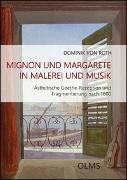| Artikelnummer | 9783487155395 |
|---|---|
| Produkttyp | Buch |
| Preis | 92,00 CHF |
| Verfügbarkeit | Lieferbar |
| Einband | Künste, Bildende Kunst allgemein, Carl Friedrich Zelter, Faust, Ferdinand Fellner, Franz Schubert, Goethe-Rezeption, Gretchen, Mignon, Robert Schumann, Wilhelm von Schadow, entdecken, Kartonierter Einband (Kt) |
| Meldetext | Lieferbar in ca. 5-10 Arbeitstagen |
| Autor | Roth, Dominik von |
| Verlag | Olms Georg Vlg. |
| Weight | 0,0 |
| Erscheinungsjahr | 2019 |
| Seitenangabe | 438 |
| Sprache | ger |
| Anzahl der Bewertungen | 0 |
Mignon und Margarete in Malerei und Musik Buchkatalog
Johann Wolfgang Goethes "Wilhelm Meister" und "Faust" sind nicht erst seit dem 20. Jahrhundert Klassiker der deutschsprachigen Literaturgeschichte. Für viele Künstler und Komponisten des frühen 19. Jahrhunderts wurden die beiden weiblichen Figuren Mignon und Margarete Musen ihres eigenen Schaffens: Unzählige Zeichnungen, Gemälde und ein kaum mehr überschaubares Korpus von Liedvertonungen haben das , Bild' Mignons und Margaretes nachhaltig geprägt - und zuweilen bis heute auf stereotype Rollenbilder reduziert.Anhand ausgewählter Bildwerke von Wilhelm von Schadow, Ferdinand Fellner und Ary Scheffer sowie Kompositionen von Carl Friedrich Zelter, Franz Schubert und Robert Schumann werden wirkungsästhetische Strukturen minutiös offengelegt. Untersucht werden das ästhetische Potential innerhalb des jeweils eigenen Mediums sowie das Vermögen von Bild und Musik, wieder auf den Text und dessen Lektüre zurückzuwirken. Die Studie leistet einen wichtigen Beitrag, die eminente Bedeutung von Bild und Musik im Kontext der Rezeption um den literarischen Klassiker Goethe aus einem neuen Blickwinkel zu betrachten, der der wechselseitig sich durchdringenden Kunstproduktion um und nach 1800 gerechter wird, als es monodisziplinäre Sichtweisen vermögen.****************The philosopher Dieter Jähnig (1926-2016) was one of the most renowned representatives of his field of study and, after gaining his doctorate under Friedrich Beißner, engaged throughout his life with the work of Friedrich Hölderlin. His famous and extremely influential lecture from the 1980s on the philosophical importance of Hölderlin's poetry is now available for the first time in book form to an wider public. Jähnig himself worked on the publication until shortly before his death, updating it where necessary.The lecture is based on his conviction that Hölderlin's poetry must interest philosophers precisely as poetry, and that we ignore its true aspirations if we consider it merely as an aesthetic subject. What we then overlook is the express relationship of this poetry with history. Hölderlin himself said that the poetry he began to write after breaking off from work on his Empedocles drama "should relate directly to the fatherland or to the age." The centre and fulcrum of this turn in his later poetry is a new understanding of language, revealed to Hölderlin by his translation of Sophocles. The language of the poem should make the inner structures of the historical action present through a "changing of tones": history is not a chronological sequence within the framework of past and present but the constant alternation of these interlocking structures, which Hölderlin called the "triple life". Dieter Jähnig demonstrates that this triadic construction is also typical of other artworks and justifies the claim that art can be taken seriously as a "language" of history.
92,00 CHF
Lieferbar


Dieser Artikel hat noch keine Bewertungen.